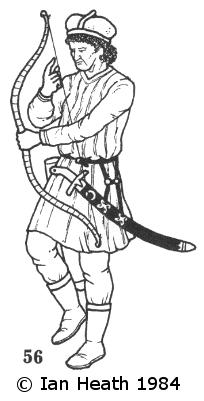
Try Amazon Audible Plus
BYZANTINE MILITIAMAN 1453
An extract from Armies of the Middle Ages, Volume 2by Ian Heath


|
56. BYZANTINE MILITIAMAN 1453
From a Moldavian fresco of 1537 depicting the fall of Constantinople, this figure doubtless represents a militiaman raised from the city’s population. These Pero Tafur described in 1437 as ‘not well-clad, but miserable and poor’, so whatever arms and armour they had would probably have been drawn from the city arsenals. Leonard of Chios describes the militia as ‘men of peace, using their shields and spears, their bows and swords, according to the light of nature rather than with any skill. The majority had helmets and body-armour of metal or leather, and fought with swords and spears. Those who were skilled in the use of the bow or crossbow were not enough to man all the ramparts, and had to do the best they could’. The least well-equipped were armed only with slings, Doukas recording slingers repulsing the Ottomans from that part of the walls where ‘the Emperor and all his Greek troops were concentrated’.
This figure is one of 7 such in the fresco, all dressed identically in red tunics, pale grey trousers and red boots, though not all of them wear the hat, which is shown as both red and pale blue. 4 of them are shown armed with composite bows, one accompanies the Emperor, and the other 2 are depicted discharging guns from the city walls.
It can be assumed that the Byzantine defenders of Constantinople included some handgunners too, even though none of the contemporary sources except Doukas seem to mention handguns amongst the Greek soldiers’ armament. (For Doukas’ references see page 22.) The majority of the handgunners present amongst the defenders were in fact provided by Italians - we are told, for instance, that the Bocchiardo brothers had provided their men with ‘fearful guns, and crossbows’. It is no surprise, therefore, to find in the ‘Ordo Portae’ that the Byzantines called the handgun skopeta, a corruption of its Italian name of schioppeto*.
*This term derived from the Mediaeval Latin sclopus or sclopitus, meaning ‘a clap’ or ‘a detonation’. At first it signified guns in general, but soon came to mean handguns in particular.